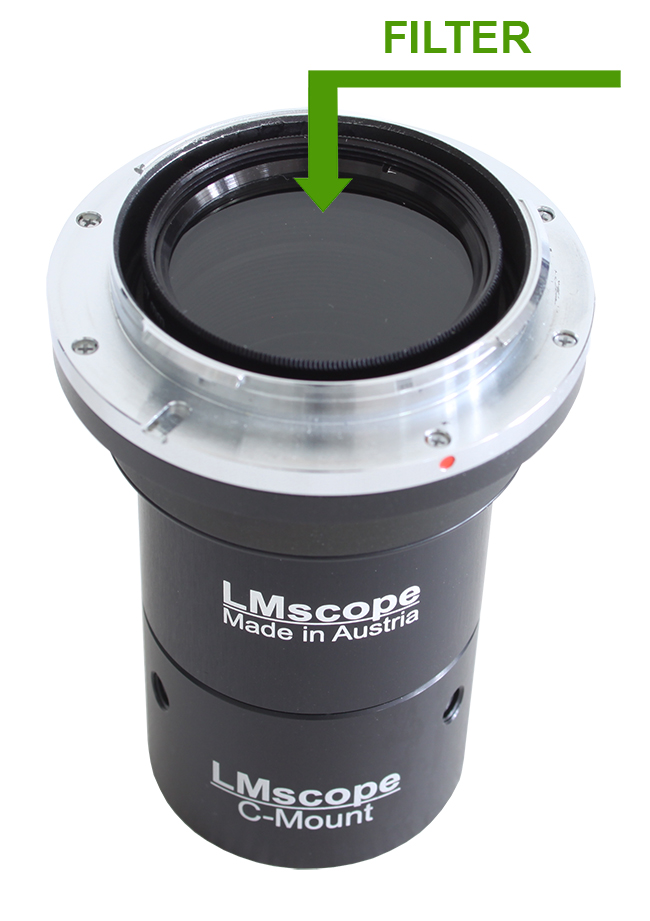

Leica M10 Monochrom: a mirrorless light-sensitive full-frame system camera for fluorescence microscopy
The Leica M10 Monochrom mirrorless system camera has been developed specifically for black-and-white photography. The absence of a colour filter array results in improved resolution and sharpness. Combined with the integrated precision optics of our LM microscope adapters, it is possible to use the full potential of the camera’s capabilities on a wide variety of microscopes.

Essentially, the M10 Monochrom shares most of its features with the M10P, which we will explore in more detail below. The M10 is the third-generation model of Leica’s M-series of black-and-white-only digital rangefinder cameras. By foregoing the colour (Bayer) filter array, more incoming light can reach the image sensor, and larger pixels are available to capture more black-and-white information. The sensor also doesn’t feature an optical low-pass filter.
To better illustrate what this means in practice, let’s take a closer look at how a camera sensor works:
The sensor of a camera consists of millions of light-sensitive spots (photosites or pixels) that capture light. The camera reads out the individual pixels and creates an image from the differences in the light captured by each pixel.

To obtain colour images, a colour filter array is placed over the photosites to provide information about the light intensity for the colours green, red or blue. It uses a grid pattern of two parts green, one part red, and one part blue to interpret the colour information arriving at the sensor. This output format is called a Bayer filter. In many cases, the pixels are arranged in a 2x2 square matrix. The received light intensity for red, blue and double the amount of green is recorded and stored by the camera.


Microscopic image of a colour sensor with Bayer filter
In addition to a Bayer filter, most cameras also have a low-pass filter, which is explicitly designed to blur high frequency data to reduce moiré artifacts, which can appear when shooting subjects with fine regular detail, such as textiles.
If, as in the M10 Monochrom, these filters are omitted, the light sensitivity of the sensor increases, because no more light is absorbed by the colour filter. There is also some sharpness gain over image sensors employing colour filter arrays.
The M10 Monochrom’s high-quality image sensor has been stepped up from 24 to 40 megapixels and achieves outstanding sharpness, detail and resolution. Compared to regular microscope cameras (e.g. C-mount cameras), this camera has a much larger full-frame sensor (36 mm x 24 mm). This large sensor is a huge advantage, especially at lower magnifications (< 50x) and for high-contrast specimens, because it enables the camera to make even the smallest details clearly visible in the photograph. Being a low-light ace, the M10 Monochrom is ideally suited for challenging low-light imaging tasks, such as fluorescence microscopy. In fluorescence microscopy, short-wave UV light excites a fluorescent dye applied to the specimen. The camera is also capable of handling native specimens with autofluorescence.
With our LM microscope adapters, the M10 Monochrom can be attached to almost any microscope. It is either connected to the eyepiece tube or (as shown below) to the phototube of the microscope. The microscope adapter features high-quality widefield optics for optimum image quality. More information on the adapter solution is available on this info page.

To use the full potential of the M10 Monochrom, our adapter systems offer the option of adding a variety of optical filters for image optimisation. Bandpass/colour filters can be used to limit the spectral range, which is an important feature for fluorescence microscopy and other special applications.

The camera retails for over EUR 8,000. It is reduced to the bare essentials of rangefinder photography – and for those who specialise in black-and-white photography, there really is no other choice because no other manufacturer can offer a comparable camera.
Conclusion: The Leica M10 Monochrom full-frame camera is an extremely powerful and versatile solution for all imaging tasks that require maximum light sensitivity and light gathering power. With our LMscope adapters, the camera can be attached to virtually any microscope, and their integrated widefield optics ensure that the largest possible field of view can be achieved without any vignetting. Our adapter systems also accommodate additional optical filters (colour filters, UV filters, polarising filters, etc.)
03.05.2023